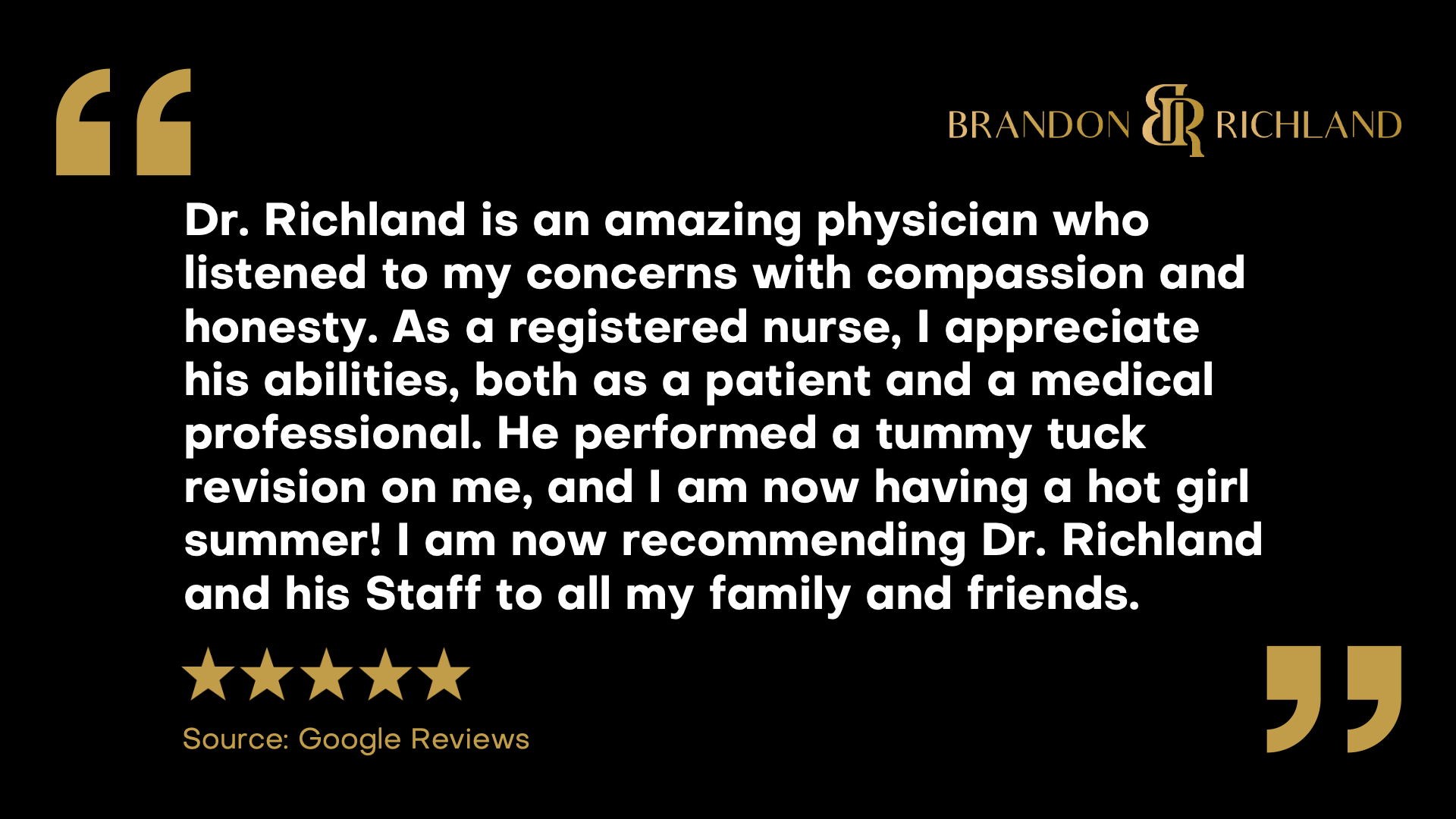Published by Dr. Brandon Richland, MD

“Dr. Richland is an amazing physician who listened to my concerns with compassion and honesty. As a registered nurse, I appreciate his abilities, both as a patient and a medical professional. He performed a tummy tuck revision on me, and I am now having a hot girl summer! I am now recommending Dr. Richland and his Staff to all my family and friends.”
Read the full Google Review here.
Understanding Tummy Tucks
In exploring the journey of enhancing abdominal contours, it is important to know the various tummy tuck procedures and the significance of selecting a qualified surgeon.
What Is Abdominoplasty?
Abdominoplasty, often referred to as a tummy tuck, is a type of plastic surgery targeted at improving the appearance of the abdominal area. It involves the removal of excess skin and fat and may include the tightening of abdominal muscles that have become separated or weakened, a condition known as diastasis recti.
Types of Tummy Tuck Procedures
Finding the right type of tummy tuck is essential based on an individual’s specific needs and goals:
- Full Tummy Tuck: This is suitable for candidates who require more extensive correction. A full tummy tuck addresses the entire abdominal area, removing excess skin, targeting fat, and tightening muscles.
- Mini Tummy Tuck: Ideal for those with concerns below the belly button, a mini tummy tuck involves smaller incisions and typically has a shorter recovery time.
- Extended Tummy Tuck: This option goes beyond the standard tummy tuck, extending the incisions around the flanks to address excess skin and fat on the sides of the abdomen.
- Reverse Tummy Tuck: Less common, this targets the upper abdomen and is sometimes performed on patients who have already undergone a traditional tummy tuck.
Patients may choose from these procedures depending on their expectations and the degree of correction needed.
Choosing the Right Surgeon
Selecting a board-certified plastic surgeon with proficiency in abdominoplasty is crucial for ensuring safety and achieving desired outcomes. Candidates should verify the surgeon’s credentials, experience with tummy tuck procedures, and their ability to leverage the latest techniques and technology to aid in a successful surgery.
- Board Certification: A surgeon’s board certification is an assurance of their expertise in plastic surgery.
- Experience: Look for surgeons who are well-versed in performing the full range of tummy tuck procedures.
- Technology & Techniques: Advanced technology and techniques can contribute to more precise results and potentially shorter recovery times.
Prospective patients are encouraged to have an in-depth consultation with their surgeon to discuss their candidacy for the surgery and realistic expectations.
The Surgical Process
The surgical process of a tummy tuck involves careful planning, a precision-focused procedure under anesthesia, and a structured recovery protocol for optimal outcomes.
Preparing for The Procedure
Prior to the surgery, patients are required to follow specific guidelines that may include cessation of smoking, avoiding certain medications and supplements, especially blood thinners, to minimize bleeding risks. A balanced diet and stable weight are encouraged for better wound healing. They are often advised to arrange for assistance post-surgery for travel and help at home.
During the Surgery
Once under general anesthesia, a horizontal incision is made just above the pubic hairline. The extent of the incision depends on the amount of excess skin. Liposuction may be used to remove excess fat. The surgeon then repairs weakened abdominal muscles with sutures and repositions the belly button to suit the newly shaped abdomen. A new opening for the belly button is created, and it is sutured into place.
- Incision: Horizontal cut above the pubic hairline
- Liposuction (if required): Removes excess fat
- Muscle repair: Abdominal muscles tightened with sutures
- Repositioning of the belly button: Necessary to conform to the new shape of the abdomen
Post-Operative Care and Recovery
After the procedure, care involves monitoring for complications such as infection or blood clots, managing pain with medication, and caring for incisions and any drainage tubes. A compression garment is applied to minimize swelling. Initial recovery may consist of limited movement to avoid strain on the sutures, and detailed guidance on caring for the wound will be provided. The healing process includes diligent follow-up appointments and adherence to a healthy lifestyle with balanced diet and exercise to maintain results.
- Immediate Post-Operative Actions:
- Monitoring by healthcare providers for any complications
- Pain management with prescribed medications
- Wound Care:
- Keeping the incision site clean and bandaged
- Incision care instructions to promote optimal healing
- Activity Recommendations:
- Avoid strenuous activity to prevent stress on the sutures
- Gradual reintroduction of light activities as advised by the surgeon
It’s important for patients to follow all post-operative care instructions meticulously to ensure a smooth recovery and to reduce the risk of complications.
Considerations and Consequences
Before considering a tummy tuck, it is vital to understand the potential risks and weigh them against the benefits. Such a procedure can significantly alter one’s abdominal profile by removing excess skin and fat deposits and tightening muscles. Here are some important considerations and consequences a person should think about.
Potential Risks and Complications
A tummy tuck, or abdominoplasty, entails certain risks and possible complications that should be considered:
- Anesthesia risks: Complications can arise from both intravenous sedation and general anesthesia.
- Infections and bleeding: As with any surgery, there is a risk of infection and excessive bleeding.
- Asymmetry: Post-operative asymmetry can occur, necessitating further correction.
- Tissue Necrosis: Fatty tissue deep within the skin might not survive, leading to fat necrosis.
- Seroma: Fluid accumulation under the skin may occur.
- Medical clearance and a thorough discussion with a certified plastic surgeon can help mitigate these risks.
Lifestyle and Future Pregnancy
Decisions around a tummy tuck also involve lifestyle considerations:
- Pregnancy: Future pregnancies can alter the results of the procedure, as the abdominal muscles that are tightened during surgery may separate again.
- Weight fluctuations: Significant changes in weight post-surgery can negate the effects.
- To maintain results, one will need to follow a healthy lifestyle, potentially including comfortable clothing initially to adapt to changes and ensure proper healing.
Costs and Insurance
Financial aspects are also a crucial part of the decision:
- The cost of a tummy tuck varies, often based on geographic location, surgeon’s fees, and anesthesia costs.
- Tummy tucks are typically considered cosmetic surgery and are not covered by insurance, though exceptions exist if there is a medical necessity.
- Patients should ask detailed questions about the total cost and any available financing if needed.
By considering these factors, individuals can make an informed decision about whether to proceed with abdominoplasty and be prepared for the journey of transformation that it entails.
Schedule Your First-Class Cosmetic Consultation with Dr. Brandon Richland, MD
Contact Dr. Richland today by visiting RichlandMD.com, scheduling a cosmetic consultation, or by calling 714-844-0398 or 949-997-2958 directly.











